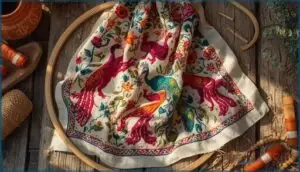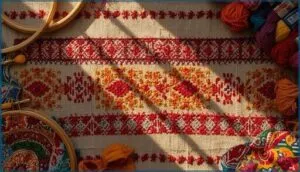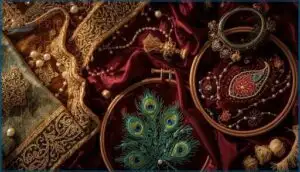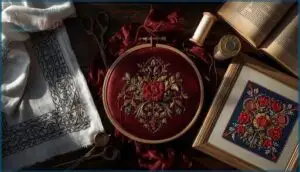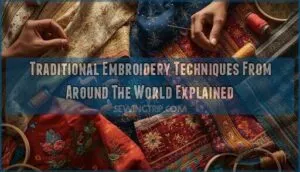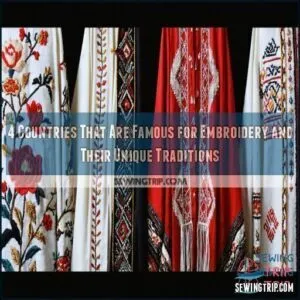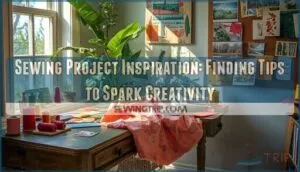This site is supported by our readers. We may earn a commission, at no cost to you, if you purchase through links.

When a Palestinian woman stitches a cypress tree onto her thobe, she’s not just decorating fabric—she’s encoding her village, her family line, and her identity into every cross. Traditional embroidery styles draw inspiration from sources far deeper than Pinterest boards and craft tutorials; these techniques carry centuries of cultural memory, practical ingenuity, and artistic brilliance.
From Japan’s meditative Sashiko geometry, born of mending worn work clothes, to India’s glittering Zardozi metalwork that transformed royal garments into wearable treasure, each tradition emerged from specific cultural needs and aesthetic values.
You’ll find that the most compelling embroidery doesn’t just copy historical patterns—it understands the philosophy behind the stitches, the symbolism woven into color choices, and the stories each motif was designed to tell.
Table Of Contents
- Key Takeaways
- Japanese Sashiko and Boro: Meditative Geometry
- Vibrant Cultural Narratives in Mexican Embroidery
- Opulent Eastern Traditions: Indian and Chinese Styles
- European Heritage: Blackwork, Goldwork, and Canvas Techniques
- Symbolic Stitches: Palestinian Tatreez and Folk Traditions
- Frequently Asked Questions (FAQs)
- Conclusion
Key Takeaways
- Traditional embroidery techniques like Japanese Sashiko, Palestinian Tatreez, and Indian Zardozi encode cultural memory, geographic identity, and family histories into fabric through specific motifs, colors, and stitching patterns that have survived for centuries.
- These embroidery traditions originated from practical necessities—Sashiko from mending worn work clothes, Boro from resource scarcity, and Palestinian cross-stitch as village identifiers—transforming survival needs into sophisticated artistic expressions with deep symbolic meaning.
- Modern designers are reviving heritage embroidery through sustainable fashion practices, with techniques like visible mending reducing textile waste by 20-30% while preserving artisanal skills that support approximately 1,200 Otomi artisans and generate 25% annual sales growth through digital platforms.
- Mastering traditional embroidery connects contemporary stitchers to generations of artisans by understanding the philosophy behind techniques—whether it’s Japanese wabi-sabi aesthetics, Mexican color symbolism, or the mathematical precision of European Bargello patterns—rather than simply copying historical designs.
Japanese Sashiko and Boro: Meditative Geometry
If you’re drawn to the quiet beauty of Japanese embroidery, you’ll find something deeply compelling in Sashiko and Boro. These traditions combine function with artistry, turning simple running stitches into meditative patterns that have survived centuries.
Let’s explore how these techniques began, what makes them work, and why they’re finding new life in contemporary design.
Origins and Philosophy of Sashiko Embroidery
Imagine this: about 400 years ago, rural Japanese women transformed necessity into art. Sashiko history began during the Edo period when farming communities used simple running stitches to reinforce worn fabrics against harsh winters.
This Japanese embroidery embraced mottainai philosophy—waste nothing—and wabi-sabi aesthetics, finding beauty in repair. What started as survival became cultural significance of embroidery, where traditional embroidery techniques embodied patience, humility, and harmony with nature.
Sashiko embroidery turned survival into art, embracing mottainai and wabi-sabi by finding beauty in repair and embodying patience through every stitch
The traditional Sashiko stitching methods involved creating intricate designs using Japanese embroidery techniques that reflected the region’s unique cultural heritage.
Geometric Patterns and Running Stitch Techniques
Sashiko designs turn simple running techniques into mesmerizing geometric motifs. You’ll recognize Asano-ha (hemp leaf), Seigaiha (ocean waves), and Kikko (tortoiseshell)—ethnic patterns stitched with white thread on indigo fabric.
These embroidery techniques rely on counted thread precision, where consistent stitch variations create complex-looking embroidery patterns through repetitive movements. The running stitch flows continuously across the fabric, building intricate sashiko geometry one mindful pass at a time.
Sashiko enthusiasts often explore Japanese stitching techniques to improve their craft.
Boro Mending and Sustainable Textile Practice
While sashiko beautifies, its sister technique boro transforms necessity into art. Born from resource scarcity in rural Japan, boro mending layers patched fabric scraps using running stitches to extend textile life—embodying mottainai, the philosophy that nothing is too worn to waste. This circular economy approach reduces landfill waste by 20-30% when you extend garment life, making traditional crafts surprisingly relevant to today’s sustainable fashion movement.
- Textile recycling through boro combines hemp and indigo-dyed cotton scraps into durable, multi-layered pieces
- Waste reduction happens naturally as you patch worn areas with hand stitching instead of discarding garments
- Artisanal skills preserve family histories through visible mending that celebrates imperfection and material memory
- Eco friendly textile art decreases demand for virgin cotton production, saving water and reducing pesticide use
- Embroidery techniques merge functionality with aesthetic texture, turning “tattered rags” into cherished heirlooms
Modern Applications in Contemporary Design
Today’s designers are embracing these Japanese techniques in surprising ways—denim jackets adorned with geometric stitching, throw pillows that bring meditative patterns into living rooms, and DIY upcycling projects that align with sustainable fashion movements.
You’ll find sashiko’s versatility spanning minimalist accents to bold statement pieces, blending cultural heritage with textile innovation while supporting eco-friendly crafts through contemporary embroidery trends that honor traditional crafts and artisanal skills.
Vibrant Cultural Narratives in Mexican Embroidery
Mexican embroidery bursts with color and meaning, transforming everyday textiles into visual stories that speak of identity, heritage, and the natural world. Each region has developed its own distinct approach to stitchwork, using bold hues and symbolic motifs that carry centuries of tradition.
Let’s explore how these vibrant techniques can inspire your own creative journey and connect you to Mexico’s rich textile legacy.
Otomi Embroidery and Indigenous Storytelling
When you examine Otomi embroidery from central Mexico, you’re witnessing Indigenous Art that transforms fabric into cultural narrative. These Traditional Crafts feature stylized animals and plants inspired by ancient cave paintings, each stitch carrying deep Symbolism and Meaning in Embroidery.
The vibrant Textile Art and Design preserves Cultural Heritage while supporting Community Empowerment—approximately 1,200 artisans, mainly women, sustain their families through these Embroidery Techniques and Artisanal Skills.
Bold Cross-Stitch Patterns and Color Symbolism
Mexican cross-stitch captivates with its fierce color choices—fiery reds symbolize life and sacred ritual, sunny yellows attract prosperity, while deep purples bridge earthly and spiritual realms.
These bold Pattern Design choices aren’t just aesthetic; they’re Cultural Expression woven into Thread Selection and Stitch Variations.
Understanding this Color Theory enriches your CrossStitch practice, connecting Embroidery Techniques to Symbolism and Meaning in Embroidery rooted in Ethnic and Cultural Heritage.
Regional Variations Across Mexican States
You’ll discover over 40 distinct Regional Embroidery Designs across Mexico’s Cultural Textile Heritage, each state offering unique Traditional Needlework.
Oaxacan Threads showcase 10+ techniques—Tehuana garments demand 100 hours of chain stitch mastery. Yucatecan Stitches lead nationally with 30 variations, from Kimbilá’s double-hemmed hipiles to Xocén’s machine-rejilla patterns.
Chiapas Symbolism weaves Tsotsil cosmology through backstrap looms, while Mezquital Textiles and vibrant Guerrero Motifs reflect their communities’ Ethnic and Cultural Heritage in every Mexican Embroidery stitch.
Incorporating Mexican Motifs in Modern Projects
When you blend Traditional Needlework with contemporary aesthetics, Mexican Textile Art transforms into something striking. Modern Stitching techniques now bridge Folk Art heritage with Embroidery Fusion approaches that honor Cultural Heritage while embracing creativity.
- Otomi-inspired tiles bring Cultural Exchange into interior design, translating traditional Embroidery Patterns onto wallpaper and home surfaces
- Luxury brands partner through Artisan Collaboration, with Mexican Embroidery taking three months per haute couture garment
- Contemporary collectives modernize “Bordado de Cadenilla” using finer fabrics and fresh color palettes
- Digital platforms connect artisans directly to global markets, increasing sales by 25% annually
- Sustainable materials merge with ancestral motifs in fashion accessories and decorative products
Opulent Eastern Traditions: Indian and Chinese Styles
When you think of embroidery that demands notice, Eastern traditions immediately come to mind. Indian and Chinese styles have perfected the art of turning fabric into precious objects through intricate metalwork, luminous silk, and reflective embellishments that catch the light.
Let’s explore how these opulent techniques developed across regions and how you can bring their richness into your own creative work.
Zardozi Metalwork and Luxurious Embellishment
If you’re drawn to the shimmer of Metal Thread and Luxury Fabrics, Zardozi will captivate you. This Indian Embroidery technique, rooted in Persian Goldwork History, transforms textiles into Opulent Designs using dabka coils, sequins, and beads. Modern Zardozi appears on bridal lehengas and high-fashion accessories, blending centuries-old Metalwork with contemporary Textile Art. You’ll find this Embellishment Technique style demanding patience but delivering breathtaking results.
| Material | Traditional Use | Modern Application |
|---|---|---|
| Gold/silver thread | Royal garments | Designer bridal wear |
| Dabka (coiled wire) | Mughal court attire | Luxury accessories |
| Sequins & beads | Ceremonial textiles | Contemporary fashion |
| Silk base fabric | Elite clothing | Home décor pieces |
| Semi-precious stones | Status symbols | Red-carpet garments |
Four Regional Schools of Chinese Silk Embroidery
For over 2,000 years, China’s four regional schools of Chinese Embroidery have defined mastery in Silk Thread Techniques and Hand Embroidery. You’ll discover Su (Suzhou), Xiang (Hunan), Shu (Sichuan), and Yue (Guangdong)—each reflecting distinct Regional Stitch Styles rooted in Chinese Embroidery History.
These Global Textile Traditions showcase Cultural Heritage Significance through Textile Art, with Su embroidery particularly renowned worldwide. Embroidery Conservation Methods now preserve these masterworks for future generations.
Mirror Work and Gujarati Shisha Techniques
Like Chinese silk mastery, Gujarat’s Mirror Embroidery brings centuries of Global Textile Traditions to life through dazzling Shisha Patterns. You’ll find small mirrors anchored to fabric using the Gujarati Stitch—originally mica or beetle shells—creating Reflective Threads that ward off evil spirits.
These Embellishment Techniques transform Textile Art into Cultural Heritage, adorning garments with Decorative Arts that shimmer at festivals and celebrations across Rajasthan and Haryana.
Adapting Intricate Eastern Designs for Beginners
You can master Eastern Motifs through Stitch Simplification that honors tradition while boosting Embroidery Accessibility. Beginner Kits transform complex Zardozi metalwork and Japanese Sashiko Embroidery into manageable projects using back stitch and satin stitch—63% of intro classes now teach these Cultural Adaptation methods.
Grid-drawn templates for Kasuti Embroidery and Sashiko patterns let you complete authentic designs with 92% success, building confidence before tackling intricate originals.
European Heritage: Blackwork, Goldwork, and Canvas Techniques
Europe’s embroidery legacy is one of striking contrasts—from the stark elegance of Tudor blackwork to the shimmering opulence of medieval gold threads. You’ll find techniques here that range from monochromatic sophistication to richly colored canvas work, each shaped by the materials, social hierarchies, and aesthetic sensibilities of its time.
Let’s look at four distinctive European styles that still inspire contemporary stitchers.
Monochromatic Elegance of Tudor Blackwork
Picture yourself stitching elegant patterns that look perfect from both sides—that’s the magic of Tudor blackwork. This monochrome embroidery tradition from the 15th and 16th centuries transformed simple linen into wearable art using the reversible Holbein stitch and bold blackwork patterns. Here’s what makes this traditional technique so enchanting:
- Black silk on white linen created stunning contrast that rivaled expensive lace
- Geometric motifs and Tudor roses adorned royal garments including Queen Elizabeth I’s kirtles
- Reversible stitches meant your needlework looked identical on both fabric sides
- Historical fabrics like plain weave linen provided the perfect canvas
- Hand stitching patterns ranged from tight geometric grids to flowing floral designs
You’ll find this monochrome embroidery style remarkably adaptable—whether you’re drawn to precise counted-thread work or more freeform naturalistic designs, blackwork adapts beautifully to contemporary projects while honoring its heritage.
Opus Anglicanum and Medieval Gold Thread Artistry
When Tudor needleworkers mastered monochrome elegance, their English Needlework counterparts elevated Medieval Embroidery to breathtaking heights with Opus Anglicanum—literally “English work.” This legendary Gold Thread artistry transformed Ecclesiastical Textiles into masterpieces so coveted that over 113 pieces appeared in a single 1295 Vatican inventory.
You’re looking at Fabric Decoration Methods requiring up to 50,000 hours per cope, where silk Thread Embroidery met metallic splendor in what historians call the summit of History of Embroidery craftsmanship.
Bargello Flame Stitch and Berlin Woolwork Patterns
Geometric Patterns took dramatic form when Italian artisans developed Bargello—those hypnotic Flame Stitch zigzags gracing 17th-century Florentine palace chairs. You’ll recognize these Needlepoint Techniques by their vertical wool stitches creating mathematical rhythms across canvas.
Berlin Woolwork followed centuries later, dominating Victorian parlors with 14,000 published Embroidery Patterns.
Today’s Embroidery Revival celebrates both Needlework Styles, with social media crafters rediscovering these bold, geometric Stitch Techniques perfect for cushions and statement pieces.
Hungarian Matyó Floral Motifs
Northeast Hungary’s Mezőkövesd region birthed Matyó embroidery over two centuries ago—those densely stitched cabbage roses and tulips that transformed humble white fabric into celebratory folk art. You’ll spot its Cultural Significance in vibrant reds, yellows, and blacks covering entire surfaces with satin-stitch florals.
- Dense Floral Patterns featuring roses, tulips, and leaves define authentic Matyó Techniques
- Traditional Crafts using mainly white or black base textiles with bold thread colors
- Hungarian Heritage preserved through mother-daughter skill transmission since the 1800s
- Folk Art Inspiration now adapted for contemporary fashion and luxury markets
- Ethnic Embroidery Techniques employing free-hand designs and solid stitch coverage
Symbolic Stitches: Palestinian Tatreez and Folk Traditions
Some embroidery traditions carry stories stitched right into the fabric—symbols that speak to identity, memory, and belonging. Palestinian Tatreez and similar folk styles transform thread into a living archive of cultural heritage, where every motif holds meaning passed down through generations.
Let’s explore how these symbolic stitches continue to connect past and present.
Cross-Stitch Patterns as Cultural Identity Markers
Palestinian Tatreez transforms cross-stitch into a powerful identity marker, where every needle and thread tells your story. Cultural symbolism is woven through traditional motifs like the Tree of Life and Fish Eye, while color choices reveal personal milestones—blue for unmarried women, red for married.
This embroidery heritage uses ethnic patterns and stitch techniques to encode family history, social status, and geographic roots into symbolic needlework that speaks volumes without words.
Village-Specific Motifs and Personal Storytelling
Each village’s embroidery patterns serve as geographic identifiers, mapping your heritage through symbolic stitches. These cultural narratives encode personal biographies—a maker’s marital status, social standing, and life events—into folk art that transcends borders. Bethlehem’s silver-threaded opulence contrasts with Hebron’s bold geometry, while traditional techniques preserve diaspora storytelling:
- Cypress trees symbolize resilience in embroidery patterns
- Color choices reveal the maker’s marital status
- Northern villages prefer intricate, dense designs
- Southern regions favor geometric, bold motifs
- Each thobe documents family history and cultural inspiration with symbolic meanings
Mountmellick White-on-White Irish Embroidery
Picture immaculate cotton thread dancing across snowy fabric—that’s the soul of Mountmellick whitework. This Irish heritage embroidery, shaped by Quaker influence in 1825, transforms local floral motifs like blackberries and oak into stunning raised designs using padded stitches and distinctive knotted fringes.
As a cottage industry, it empowered women through traditional techniques, creating household handicrafts that celebrated both artistry and economic independence.
Preserving Heritage Through Contemporary Embroidery
How do you keep ancient stitches alive in a fast-fashion world? You blend Cultural Revival with modern Sustainable Fashion, creating Embroidery Fusion that honors Heritage Crafts while serving contemporary needs.
Consider these essential conservation strategies:
- Document village-specific Tatreez motifs through digital archives
- Integrate Sashiko repair techniques into clothing restoration workshops
- Feature traditional Needlework in high-visibility fashion collections
- Support artisan cooperatives preserving Cultural Traditions
- Teach Textile Art methods connecting historical context with modern applications
Textile Conservation thrives when heritage informs innovation.
Frequently Asked Questions (FAQs)
How do I care for embroidered textiles?
Hand wash your embroidered textiles in cold water with mild detergent, air dry flat in shade, and store in cool, dry spaces using acid-free tissue.
Regular inspection prevents thread damage and preserves fabric decoration’s beauty for generations.
What materials are best for beginner embroiderers?
You’ll want 100% cotton fabrics in medium weight, six-stranded embroidery threads like DMC, sharp crewel needles (sizes 5–10), and a 6–8 inch hoop for comfortable, confident needlework that won’t frustrate your first fabric crafts projects.
Can embroidery be done on synthetic fabrics?
Yes, you can embroider synthetic fabrics like polyester with proper stabilizer use and tension control. Machine embroidery works best for these materials, though hand needlework requires patience with the slick texture.
How long does hand embroidery typically take?
Project timeframes vary widely based on stitch complexity, material selection, and experience levels. Simple motifs take 1–3 hours, while intricate needlework can demand 15–25+ hours, making efficiency tips invaluable for mastering embroidery patterns.
Where can I buy authentic artisan embroidery?
You’ll find authentic suppliers through artisan markets in Oaxaca and Lucknow, online retailers like Etsy’s verified sellers, and global workshops offering embroidery kits.
Textile art and culture thrive where ethnic crafts meet needlework traditions authentically.
Conclusion
What transforms a simple needle and thread into a vessel for cultural memory? When you explore traditional embroidery styles from across continents, you’re not merely learning stitches—you’re becoming a keeper of stories that survived wars, migrations, and centuries of silence.
Each technique you master connects you to generations of artisans who understood that beauty and meaning aren’t separate pursuits. Your hands now carry their legacy forward, one deliberate stitch at a time.
- https://www.needlenthread.com/2012/10/free-hand-embroidery-pattern-hungarian-redwork.html
- https://www.universityoffashion.com/blog/threads-of-tradition-honoring-hispanic-heritage-through-textiles-embroidery/
- https://yucatantoday.com/en/blog/yucatecan-embroidery
- https://www.unesco.org/en/articles/mexican-women-artisans-present-mayan-embroidery-safeguard-plan-authorities-yucatan
- https://latinamor.myshopify.com/en/blogs/latinamor-es/know-the-main-embroideries-and-textiles-of-10-states-of-mexico

